 There was a video on Facebook a few weeks ago about Buddy Benches being placed in schoolyards. The video explained the importance of the communication and training that is essential to their use and effectiveness.
There was a video on Facebook a few weeks ago about Buddy Benches being placed in schoolyards. The video explained the importance of the communication and training that is essential to their use and effectiveness.
The essence of the Buddy Bench is for inclusion and safety. Kids who feel alone and have no one to enjoy their recess time with are encouraged to sit on the bench – as a signal that he/she is in need of a friend, a buddy, a playgroup to join. Conversely, when the Buddy Bench has a person sitting on it, the kids who are enjoying their recess time, are chartered to practice being a Buddy…by sharing friendship, to invite the person into their group, to ask what might be troubling the bench-sitter, to provide protection from a bully; the list of helpful acts extended from the community of kids towards the person in need of a buddy is heartwarming.Buddy Benches serve as a safe place for kids who are feeling bullied or for kids to make new friends.
In exploring Buddy Benches, I learned that they are multiplying; they are in many school districts across the country. Some Boy Scout troops are now making Buddy Benches for schools for their badge-earning credits. The Buddy Bench is a simple idea to lessen loneliness, to counter bullying, and to foster friendship and a sense of belonging. Buddy Benches provide the symbolic learning space for both asking for help and, in return, receiving the extended hand of friendship.
After learning about this uplifting idea, I thought about inclusion within our workplaces and about being our brother’s/sister’s keeper – simply because it is the right thing to do – ensuring we have each other’s back. I thought about OSHA’s workplace bullying guidance, the connection to the General Duty Clause, and knowing that escalating workplace bullying, harassment, and intimidation is linked to poorer safety performance as well as employee mental and physical wellbeing. And, of course, I thought about employee accountability – we are each accountable for our behaviors. I thought about the culture of our workplaces being strongly related to the worst behaviors we are willing to tolerate. I thought about that old book, “All I Really Need to Know I Learned in Kindergarten,” by Robert Fulghum. Remember those simple truths?
How our work worlds would be improved if we all adhered to the same basic rules as children: sharing, being kind to one another, no hitting, cleaning up after themselves, learning together, etc. Maybe we need to place something like Buddy Benches in our workplaces. What do you think?
 At one of the highest geographical points in Florida, at Lake Wales, is a large, 205-ft high, carillon tower. It is beautiful, as are the gardens surrounding this tower structure, made of glistening coquina stone. The tower and gardens were a gift from benefactor Edward W. Bok, who cared deeply about nature, beauty and sanctuary spaces. Millions of visitors have traversed this place of solace since it opened in 1929. Edward Bok was all about CARING for future generations – to be able to enjoy peace and beauty. His tribute signature is this:
At one of the highest geographical points in Florida, at Lake Wales, is a large, 205-ft high, carillon tower. It is beautiful, as are the gardens surrounding this tower structure, made of glistening coquina stone. The tower and gardens were a gift from benefactor Edward W. Bok, who cared deeply about nature, beauty and sanctuary spaces. Millions of visitors have traversed this place of solace since it opened in 1929. Edward Bok was all about CARING for future generations – to be able to enjoy peace and beauty. His tribute signature is this: For our workplaces, this is about the way we think about safety, the way we engage around safety, and the way we bring a third unifying force to the whole culture of safety.It’s the missing link in our respective workplaces. Without it, we tend to stay engulfed in a culture of compliance, yet despite trying and trying, we never reach excellence. Without it, we keep repeating the same mistakes – round and round we go.
For our workplaces, this is about the way we think about safety, the way we engage around safety, and the way we bring a third unifying force to the whole culture of safety.It’s the missing link in our respective workplaces. Without it, we tend to stay engulfed in a culture of compliance, yet despite trying and trying, we never reach excellence. Without it, we keep repeating the same mistakes – round and round we go.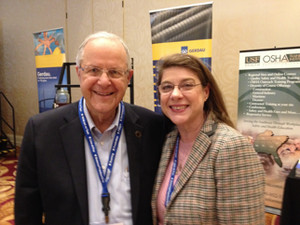 I spoke about Partner-Centered Safety™ and the importance of this as the quickest way to achieve sustainable safety excellence. As many of you know, I have written and spoken about this many times over the last several years. The information and data I share clearly shows that this approach to leading safety is very powerful, producing improved results quite quickly. Many of you have seen the terrific results the people at the DuPont, Belle Plant achieved. This approach has a very strong scientific basis in complex adaptive systems theory.
I spoke about Partner-Centered Safety™ and the importance of this as the quickest way to achieve sustainable safety excellence. As many of you know, I have written and spoken about this many times over the last several years. The information and data I share clearly shows that this approach to leading safety is very powerful, producing improved results quite quickly. Many of you have seen the terrific results the people at the DuPont, Belle Plant achieved. This approach has a very strong scientific basis in complex adaptive systems theory.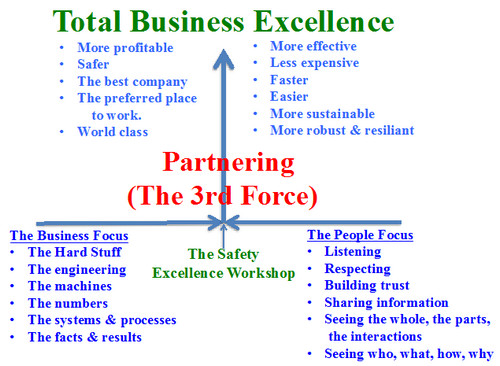
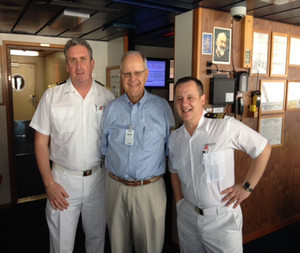 On December 16-18, 2015, I was able to attend the Cruise Line International Association Safety Conference in Miami. The focus was on improving the safety culture and Bridge Resource Management. This is a very interesting business for me to learn about. I was there to give some perspective from the chemical industry.
On December 16-18, 2015, I was able to attend the Cruise Line International Association Safety Conference in Miami. The focus was on improving the safety culture and Bridge Resource Management. This is a very interesting business for me to learn about. I was there to give some perspective from the chemical industry.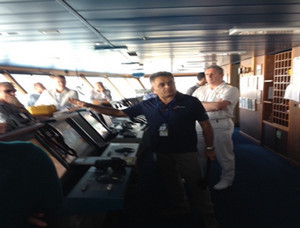 There is a big need to be sure the managers of chemical plants are qualified so that their employees and neighboring communities do not suffer the consequences of chemical releases and spills. Many manufacturing businesses that do hazardous work, aside from chemical manufacturing, should heed this thinking too.
There is a big need to be sure the managers of chemical plants are qualified so that their employees and neighboring communities do not suffer the consequences of chemical releases and spills. Many manufacturing businesses that do hazardous work, aside from chemical manufacturing, should heed this thinking too. I’m reminded about the organization that thought their safety performance was always good, because they were primarily an office environment. They scoffed over how bad could a paper cut be? Or, what’s the worst that could happen if someone fell off their chair? Little did they expect that one of their office workers, when on a healthy outdoor walk during her scheduled break time, tripped over some roped off tape that had been blown by the wind. She actually walked into it – not paying attention to her surroundings – got caught up in it as it wrapped about her feet. She fell, twisted her knee, required surgical repair, etc., etc. Try to explain that office worker lost-time injury! (The good: healthy walk; The bad: not paying attention; The ugly: lost time injury).
I’m reminded about the organization that thought their safety performance was always good, because they were primarily an office environment. They scoffed over how bad could a paper cut be? Or, what’s the worst that could happen if someone fell off their chair? Little did they expect that one of their office workers, when on a healthy outdoor walk during her scheduled break time, tripped over some roped off tape that had been blown by the wind. She actually walked into it – not paying attention to her surroundings – got caught up in it as it wrapped about her feet. She fell, twisted her knee, required surgical repair, etc., etc. Try to explain that office worker lost-time injury! (The good: healthy walk; The bad: not paying attention; The ugly: lost time injury).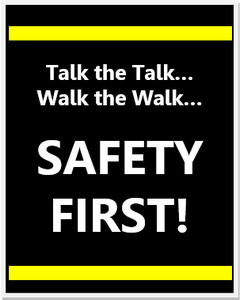 We see organizations as complex adapting networks of people who are the vital keys to its success. When the people in the various parts of the network are sharing information and helping each other, all aspects of EHS Performance rapidly improves, resistance to change disappears and the energy bubbles up spilling over into all other parts of the work lifting the organization to new, higher levels of performance.
We see organizations as complex adapting networks of people who are the vital keys to its success. When the people in the various parts of the network are sharing information and helping each other, all aspects of EHS Performance rapidly improves, resistance to change disappears and the energy bubbles up spilling over into all other parts of the work lifting the organization to new, higher levels of performance.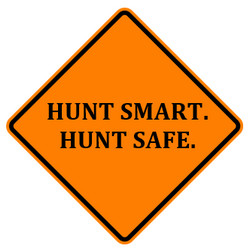 In many places, the hunting season is underway or just beginning. This is always a time of change and hazard. Some years when I was a plant manager, we would have one or two serious hunting-related, off-job injuries – like falling from a tree stand or tripping over something and breaking a leg. There is a lot of change as people go into the woods and fields looking for game. Many have not done this for a while. Others may not be fully prepared for a sharp change in the weather where a heavy rain could come in or the temperatures drop below freezing and hypothermia becomes a worry. It is often dark and visibility is poor. I have read of hunters getting killed with their own weapon when they have tripped and accidentally shot themselves. Don’t load your gun until you are ready to use it.
In many places, the hunting season is underway or just beginning. This is always a time of change and hazard. Some years when I was a plant manager, we would have one or two serious hunting-related, off-job injuries – like falling from a tree stand or tripping over something and breaking a leg. There is a lot of change as people go into the woods and fields looking for game. Many have not done this for a while. Others may not be fully prepared for a sharp change in the weather where a heavy rain could come in or the temperatures drop below freezing and hypothermia becomes a worry. It is often dark and visibility is poor. I have read of hunters getting killed with their own weapon when they have tripped and accidentally shot themselves. Don’t load your gun until you are ready to use it.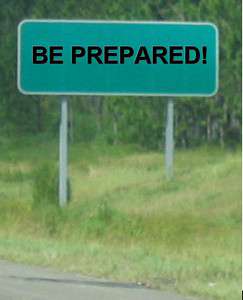 I have been talking about checklists in my previous newsletters and they can be useful as people go out hunting.
I have been talking about checklists in my previous newsletters and they can be useful as people go out hunting. I recently read of a fatal accident where a man was killed while working on a lathe. It was properly shielded and okay for the normal conditions, but the unexpected happened. The part he was working on exploded apart under the high rotating speed when he engaged the cutter. The parts from the exploding piece went right through the shield and gave him terrible, fatal wounds.
I recently read of a fatal accident where a man was killed while working on a lathe. It was properly shielded and okay for the normal conditions, but the unexpected happened. The part he was working on exploded apart under the high rotating speed when he engaged the cutter. The parts from the exploding piece went right through the shield and gave him terrible, fatal wounds.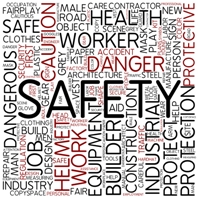 Another thing that can happen around hunting season and the holidays is the need to hire temporary people to backfill for those who are out. These people need extra care and attention, but things are often so busy that it is hard to give it to them. These people just don’t know the hazards.
Another thing that can happen around hunting season and the holidays is the need to hire temporary people to backfill for those who are out. These people need extra care and attention, but things are often so busy that it is hard to give it to them. These people just don’t know the hazards. In many of my newsletters, I have talked about the importance of sharing information abundantly, building relationships of trust and interdependence, and helping people to see the importance of their own work in building the success of the whole organization.
In many of my newsletters, I have talked about the importance of sharing information abundantly, building relationships of trust and interdependence, and helping people to see the importance of their own work in building the success of the whole organization.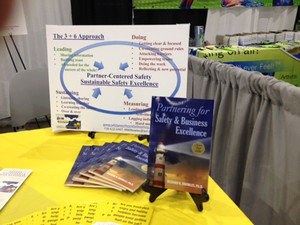 At our exhibit booth, Claire and I shared our Partner-Centered Leadership approach. We handed out brochures and other literature that can help organization’s achieve safety excellence and move towards their OSHA Star designation. We were there to share important information, including the need to be able to lift up and address one’s safety elephants that are preventing organizations from being the best they can be.
At our exhibit booth, Claire and I shared our Partner-Centered Leadership approach. We handed out brochures and other literature that can help organization’s achieve safety excellence and move towards their OSHA Star designation. We were there to share important information, including the need to be able to lift up and address one’s safety elephants that are preventing organizations from being the best they can be. The keys for addressing both of these concerns in building sustainability into their programs and in achieving the OSHA Star status is for the people at all levels and parts of the organization to talk together to get clear and aligned on just what they really want to do. How sincere and authentic is the desire to have safety excellence for the long-term? (This means Communication with a Capital C—requiring Co-creation, Clarity and Coherence.) In addition, together they must take the time to co-create a set of ground rules about how they agree to work together in order to achieve their safety goals and then hold each other accountable to live up to them. (That’s Partnership and Commitment!) The process to achieve this is available to you and your organizations now.
The keys for addressing both of these concerns in building sustainability into their programs and in achieving the OSHA Star status is for the people at all levels and parts of the organization to talk together to get clear and aligned on just what they really want to do. How sincere and authentic is the desire to have safety excellence for the long-term? (This means Communication with a Capital C—requiring Co-creation, Clarity and Coherence.) In addition, together they must take the time to co-create a set of ground rules about how they agree to work together in order to achieve their safety goals and then hold each other accountable to live up to them. (That’s Partnership and Commitment!) The process to achieve this is available to you and your organizations now.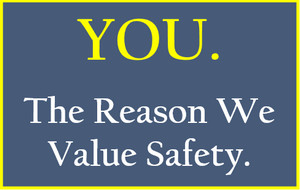 This is all about having everyone go home in one piece and having a profitable business. Excellence in both the safety performance and business results are attainable.
This is all about having everyone go home in one piece and having a profitable business. Excellence in both the safety performance and business results are attainable.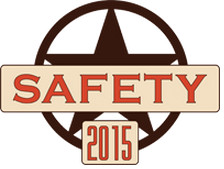 “
“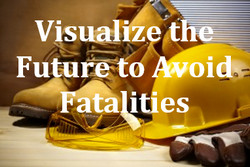 In my reading, studying and talking with many people, I have found that over half of the fatal accidents are often unanticipated and missed using our traditional approaches to accident prevention. The Heinrich Accident Triangle is very useful as we look at unsafe acts at the base of the triangle. Lots of slips, trips and falls are avoided as we do this.
In my reading, studying and talking with many people, I have found that over half of the fatal accidents are often unanticipated and missed using our traditional approaches to accident prevention. The Heinrich Accident Triangle is very useful as we look at unsafe acts at the base of the triangle. Lots of slips, trips and falls are avoided as we do this.




